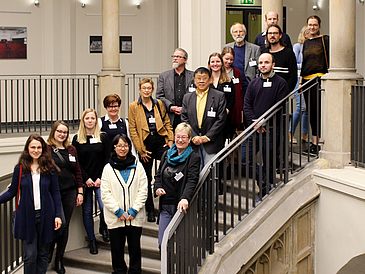An expert look into the hall where Bremen history is written is worthwhile. The honeycomb-style structure of the Bremen Parliament was created in 1966. With the exception of a few technical innovations, everything has remained as it was because it has been a protected building since 1993. Alumni look at the palisade wood walls and the 1960s loudspeakers that look like lamps, and, with interest, read the name signs of the members of parliament on the tables where they sit.
Science-Policy Spokespeople Provide Information
Reinhard Ahlers, treasurer of the association, moderates the program. Arno Gottschalk for SPD, Miriam Strunge for The Left, Henrike Müller for The Greens, Susanne Grobien for CDU, and Magnus Buhlert for FDP take their seats on the bench where senators usually sit. They are science-policy spokespeople for their parties, and the atmosphere here is intent.
“Transfer” Is the Magic Word
The main topic is the 2025 academic plan. Gottschalk highlights positive key data: Instead of 352 million euros as before, the state of Bremen intends on supporting its universities with 542 million euros over the next five years. If the money from the federal government is added to this figure, this totals 600 million euros, he says. “Time for innovation and strategy,” adds Henrike Möller and brings the magic word of “transfer” into play, which alumni also address in the discussion. Miriam Strunge of The Left thinks it would be good if old mistakes were reversed and the sports degree course were reintroduced. Others don’t like the idea so much since it is just before a state election.
“Keep Pace”
Susanne Grobien expressly supports the Unibad pool: “I wouldn’t want to do without the 50-meter lane.” But how can it be financed? The large sum of money that will be used to underpin the recently adopted academic plan must not only be used to pay for infrastructure. The university alone intends to create 237 new jobs for scientists, including 32 professorships. Magnus Buhlert underlines: “We have to work through a backlog of refurbishments, but should not be under any illusions that we could be on the cutting edge in terms of equipment. It’s more about Bremen keeping up.”
Limitations and Opening Hours
The alumni ask many questions: What about medicine? Will there be full-time courses or only a clinical part? Will humanities receive sufficient attention, especially when they are small degree courses? Should Jacobs University continue to be funded with millions of euros? What will happen to fixed-term jobs in the academic sector? Will the library extend its opening hours sufficiently? Will it be open on Sundays? Or late in the evenings?
Photo in Börsenhof A
The successful and informed discussion from both sides only ends after 90 minutes. For the souvenir photo, the alumni line up at Börsenhof A (because there are so many they line up in two rows). They arrange themselves on a breathtaking curved staircase from the 19th century under a semicircular atrium with a view of three arches, which is accessible via a glass bridge – something you don’t usually see.

